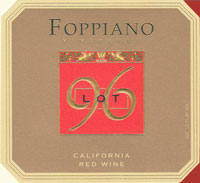|
|
Lot 96, Bin 002, California |
 |
|
Wine Details
Price:
$12.00 per bottle
Description:
Foppiano Vineyards Lot 96, Bin 002 is a red wine crafted by Foppiano Vineyards. The name “Lot 96” was chosen to reflect Foppiano’s original roots, dating back to 1896. After all of these years, we’re still family owned and operated. While we continue to embrace our past, we’re also deeply rooted in the present. Lot 96 is our way of bringing a great value wine to you. Lot 96 is a wine that you can simply enjoy with your everyday meals and share with your family and friends.
|
|
|
Reviews
|

|
|
|
Back to Foppiano Vineyards information
|
|
|